China's Top-Ten archaeological discoveries of 2004 were
announced in Beijing on April 17, 2005:
1. Prehistoric Site at Beifudi, Yixian
County, Hebei
Province.
2. Neolithic Cemetery in Ruicheng County,
Shanxi Province.
3. Palatial Site at Erlitou of Xia and
Shang Dynasties, Yanshi, Henan Province.
4. Burial Site from the Bronze Age, Lop Nur,
Xinjiang.
5. Ruins from the Western Zhou Period,
Tanheli, Ningxiang County, Hunan Province.
6. Tombs for Nobles of the Yue State, Wuxi
City, Jiangsu Province.
7. Southern Gate of Longcheng Palace in
Chaoyang City, Liaoning Province.
8. Southern Han Mausoleums in Guangzhou,
Guangdong Province.
9. Southern Song Imperial Road Remains in
Hangzhou City, Zhejiang Province.
10. Winery Remains in Mianzhu City,
Sichuan Province.
1. Prehistoric Site at Beifudi, Yixian
County, Hebei Province.
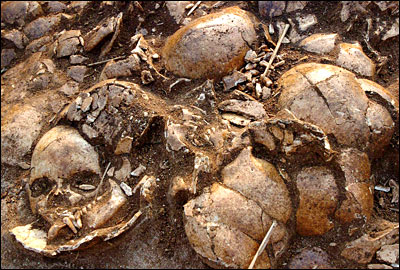
The Neolithic site (dating back about 7,000-8,000
years) was excavated by a team from the Cultural Relics Research
Institute of Hebei Province, led by Duan Hongzhen.
The Beifudi site, first discovered in 1985, is by far one of the
most important prehistoric sites in Hebei Province, boasting great
significance in the research on prehistoric civilization in North
China.
The first-phase Neolithic site is the most significant discovery
of the three prehistoric digs made between 2003 and 2004, as it
contains relics of a culture that existed close to the Cishan and
Xinglongwa cultures of about 6,000-5,000 BC, which fills up the
regional blanks between the two cultures.
A great number of dwellings and ash-pits were excavated, as well
as sacrificial sites, jade and stone pieces, pottery, and carved
ceramic masks. The masks are so far the earliest and the most
well-preserved masks from prehistoric times, providing new
important material for the study of primitive religion and
wizardry, and shedding light on early Neolithic culture in North
China and the spiritual life of the ancients.
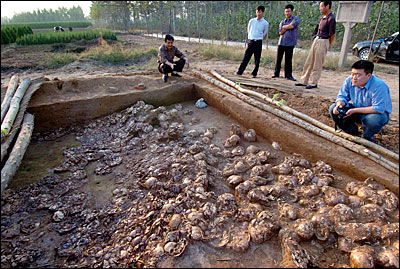
The Beifudi site at is located where the three
prehistoric cultures of the Central Plains, North, and Shandong
meet, which makes it important in the study of the comprehensive
relations among the three cultures. The site is the remains of a
large Neolithic village.
2. Neolithic Cemetery in Ruicheng
County, Shanxi Province.
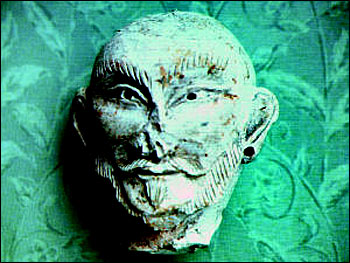
In October 2003, a team from the Shanxi Provincial
Cultural Relics and Archaeology Institute conducted a small-scale
excavation at a Neolithic cemetery first found in 1955. The
cemetery of the Miaodigou II Culture is located to the northeast of
the Qingliang Temple, a Yuan Dynasty Buddhist monastery, in
Ruicheng County in north China's Shanxi Province, covering an area
of nearly 5,000 square meters. The following year, the team
launched a second excavation project, digging the cemetery more
extensively. By November, they had unearthed a total of 262 tombs,
and found more than 200 funerary objects made of jade.

According to team leader Xue Xinming, in general, the
larger tombs were 1.3-1.8 meters wide and 2.3-2.6 meters long. They
were arranged in proper order and those buried must have belonged
to the same tribe. Archaeologists also found two sets of smaller
more ancient tombs, about 0.5-0.8 meters wide and 2 meters long.
The cemetery was created during a period of great change for the
Central Plains (a birthplace of the Chinese civilization, referring
to the middle and lower reaches of the Yellow River). During this
time, different cultures met and mingled here. The finds in the
cemetery have shed new light on the study of the origin of the
Chinese civilization.
3. Palatial Site at Erlitou of Xia
and Shang Dynasties, Yanshi, Henan Province.
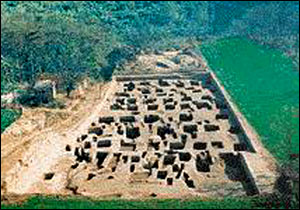
In July 2004, a team from the Archeological Research
Institute of Chinese Academy of Social Sciences, led by Xu Hong,
discovered the remains of a palace at Erlitou in Yanshi City in
central China's Henan Province.
Covering 108,000 square meters, the rectangular city was about
300 meters wide from east to west, and 360 meters long from north
to south. In the palace grounds, nine large building sites have
been dug up, two of them revealing obvious axial lines. The ruined
sites, dating back about 3,600 years to the era of Xia (21-16th
century BC) and Shang (16-11th century BC) dynasties, reportedly
make up the earliest palace grounds ever found in China.
Criss-crossing roads formed the transportation network in the
palace's central area. The square-shaped palace complex and the
roads were all lined up in an orderly way, indicating that the
palace grounds had a clear layout, which might have served as the
model for the construction of later imperial palace grounds.
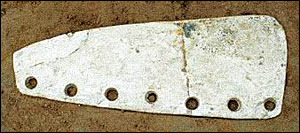
Important relics, such as wheel tracks, and the
remains of turquoise ware making workshops, were also found. The
discovery of two-wheeled tracks pushes back the appearance of
two-wheeled vehicles in China to as early as the Xia Dynasty.
In addition to the discovery of the said tracks, a large
turquoise dragon ware was excavated, which is believed to be the
earliest dragon-shaped totem. The dragon, about 70 centimeters long
and made up of 2,000-odd various fine pieces of turquoise, is a
rare antique in terms of scale, exquisiteness, and weight.
4. Burial Site from the Bronze Age,
Lop Nur, Xinjiang.
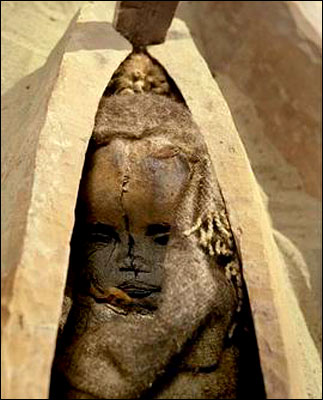
A local hunter found the location of the tomb complex
in 1910, and later guided Swedish explorer and archeologist Folke
Bergman there in 1934.
The full-scale excavation project was launched in October 2003
by the Xinjiang Cultural Relics and Archaeology Institute, led by
Idresi Abdulres, with the approval of the State Administration of
Cultural Heritage.
A total of 167 tombs have been dug up since the end of 2002. In
addition, the excavated complex has revealed hundreds of smaller
tombs built into several layers, and other precious relics.
The exterior of the site is an oblong sand dune, from which more
than 30 well-preserved mummies have been excavated. The mummies
were buried in air-tight ox-hide bags.
The Xiaohe Tomb complex, which sprawls over 2,500 square meters,
actually contains about 330 tombs. Unfortunately, about 160 of them
have been desecrated by grave robbers.
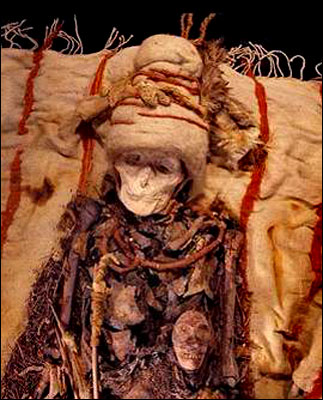
The most startling discovery was four wooden coffins
buried in the deepest layers of the complex. The bodies of four
women lie in four boat-like coffins with woolen mantles, gold
earrings and caddice necklaces. What makes this discovery so
startling is the fact that not a speck of dust has sullied any of
the coffins. Tall timber structures symbolizing the reproductive
organs of males and females stand atop the sand dune.
The Xiaohe tomb complex is 175 kilometers from the ruins of the
Loulan Kingdom, an ancient civilization that vanished 1,500 years
ago. The rediscovery of the tombs will no doubt play a very
important role in the research of the Loulan civilization and
climatic changes that have taken place in Lop Nur.
5. Ruins from the Western Zhou
Period, Tanheli, Ningxiang County, Hunan Province.
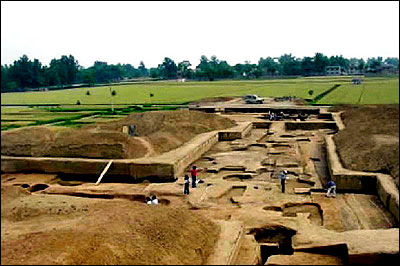
The site was excavated by the Cultural Relics and
Archeological Research Institute of Hunan Province in 2004. The
excavation team was led by Xiang Taochu.
The team found a city wall from the Western Zhou Period (11th
century-771BC) at Tanheli, Ningxiang County, Hunan Province. Part
of the discovery included two large-sized artificial building
sites, consisting of yellow earth, and two larger-sized sites,
possibly palatial dwellings. Remains of moats from the same period
were also discovered both inside and outside the city. Seven small
tombs for nobles and lords were dug up in the highlands outside the
city, from which a large number of bronze and jade wares were also
excavated.
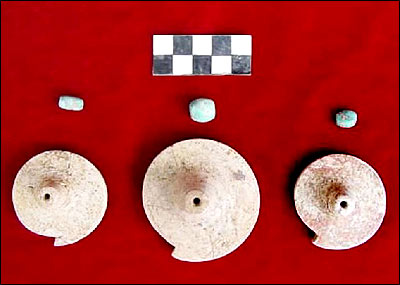
This was the first time that the ancient city ruins of
the Western Zhou Period were discovered in Hunan Province. The site
is of great significance to the study of Hunan's regional history,
bronze culture, and the formation of early state and society. The
site also provides important material objects for researching the
bronze civilization in the Western Zhou Period in the Xiangjiang
River valley and the southern area as a whole.
6. Tombs for Nobles of the Yue State,
Wuxi City, Jiangsu Province.

The tombs at Hongshan Town, Xishan District, were
excavated jointly by the Nanjing Museum Archaeology Institute and
Xishan District Cultural Relics Management Committee of Wuxi.
Leading the project was Zhang Min.
The findings give clues on the burial rites for nobles of the
Yue State (770-446BC). The tombs are of varying sizes, presumably
in accordance with the ranking of the nobles, of which there were
five. More than 2,000 pieces of burial articles were found in the
seven tombs successfully excavated.
One of the tombs at Qiuchengdun stretches some 57 meters in the
shape of the Chinese character "zhong" (which means
"center" and characterized by a rectangle with smooth edges and a
long line down the middle). It is the second largest ever made for
a noble of the Yue State, second in size only to the tomb of the
King of Yue at Yinshan, Shaoxing in Zhejiang Province.
A total of 1,100 funerary articles were found, including
complete sets of pottery, musical instruments and jade wares. The
500-odd porcelain musical instruments, about 10 varieties, make the
tomb the largest underground storehouse of ancient instruments ever
discovered, which includes the yongzhong (a type of bell)
and qing (chime stone) from the central plains,
chunyu (a metal percussion instrument), dingning
(a bell with a handle), duo (big bell) and ling
(little bell), which were made in typical Yue style. More
significant was the discovery of the fou, a clay musical
instrument whose existence could not be confirmed until now.
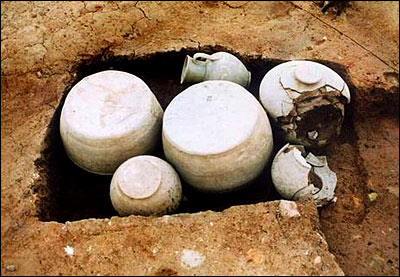
The site can be compared, in terms of number and
variety of musical instruments, with the Mausoleum of Marquis Yi of
the Zeng State (around 433 BC), which is famous for its Zeng Houyi
Bells, the largest set of bronze bells excavated in the world, and
its stone chimes.
The site's four spherical pottery pieces in red, blue, and white
glaze, each made of eight coiling snakes, are rare research
materials that can aid in the study of the origin of glass and the
cultural exchanges between China and other countries.
The tomb site dates back to the early years of the Warring
States Period (475-221BC), possibly during the reign of King
Goujian who took the throne in 496 BC. The findings mark the most
important archaeological discovery on the State of Yue to date. The
site not only has far-reaching significance on the study of Yue
history and culture, but may also help rewrite part of the ancient
history of not only this region, but also that of music and
porcelain making.
7. Southern Gate of Longcheng Palace
in Chaoyang City, Liaoning Province.
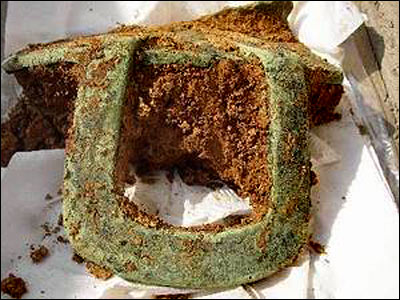
Following a brief unification during the Western Jin
Dynasty (265-316), the country was divided once again. South China
came under the rule of the Eastern Jin Dynasty (317-420), while 16
ethnic regimes, known as the Sixteen States (304-439), were
established one after another in the north.
Chaoyang City in northeast China's Liaoning Province was the
capital -- then named Longcheng (Dragon City) -- of Pre-Yan
(337-370), Post-Yan (384-407) and Northern Yan (407-436), three of
the 16 ethnic regimes. The municipal government started a
resettlement project in 2003 to give the 1,600-year-old city a
facelift. In a coordinated effort, from July 2003 to December 2004,
a team from the Liaoning Provincial Cultural Relics and Archaeology
Institute dug a total area of over 10,000 square meters at 11 sites
of the ancient capital, and unearthed a number of relics dating
from the Sixteen States to the Qing Dynasty (1644-1911).
Of the discoveries, one still stands on what is known today as
Beidajie (Northern Street), and archaeologists think it might be
the south gate of Longcheng Palace. This gate is believed to be one
of the most important finds of the year-long excavation
project.
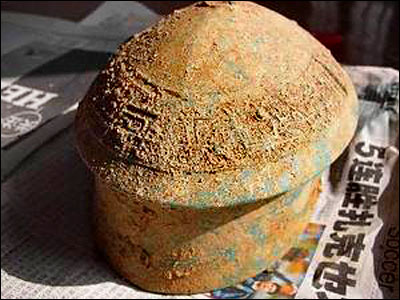
"This gate was initially built in the Pre-Yan,
reconstructed during the Post-Yan, Northern Yan, Northern Wei
(386-534), Tang (618-907), Liao (or Chitan, 916-1125) and Kin
(1115-1234) dynasties, and completely discarded in the Yuan Dynasty
(1279-1368)," said team leader Tian Likun. Its well-preserved
gateway provides significant clues to the study of ancient cities
in north China during the Sixteen States era. And more important,
the discovery of the southern gate will help in the restoration of
Longcheng's original overall arrangement.
8. Southern Han Mausoleums in
Guangzhou, Guangdong Province.
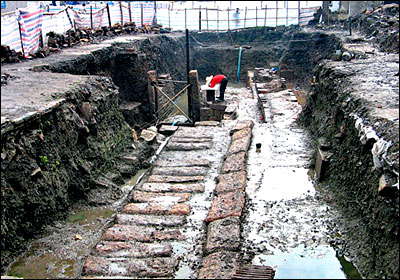
From June 2003 to October 2004, a team from the
Guangzhou Municipal Cultural Relics and Archaeology Institute
conducted a survey and salvage excavation project in tandem with
the construction of the Guangzhou University Town on the Xiaoguwei
Island in Guangzhou, the capital of south China's Guangdong
Province.
The dig turned out to be extremely fruitful with the discovery
of two large brick tombs, which were later determined by
archaeologists to be the royal Deling and Kangling mausoleums of
the Southern Han (917-971).
The short-lived Southern Han state was a separatist state
established in south China during the Five Dynasties and Ten States
(902-979) period. It's the second local regime in Chinese history
that established its capital in Guangzhou following the Southern
Yue (204-111 BC) era. In its heyday, the Southern Han territory
covered today's Guangdong and Hainan provinces and Guangxi Zhuang
Autonomous Region as well as parts of Yunnan and Guizhou.
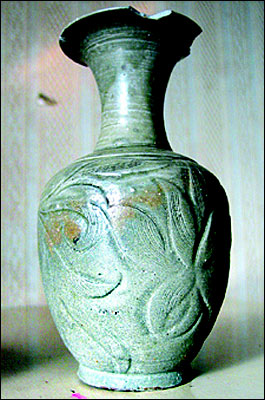
The Kangling mausoleum, in which King Liu Yan was
buried in 942, is situated on the southern slope of the Daxiang
Hill. A park covering an area of some 5,550 meters was built on the
grounds, while the underground coffin chamber measuring 11 meters
long, 3.15 meters wide and 3.3 meters high was constructed with
bricks and decorated with murals. A tablet inscribed with a funeral
oration unearthed from the tomb is the oldest to have been found in
China.
The Deling, in which King Liu Yin, Liu Yan's brother, was
buried, is on the northern slope of the Qinggang Hill, only 800
meters away from Kangling. Although it is not as large as Kangling,
190 celadon pots and 82 glazed ceramic jars were found in the well
preserved mausoleum, all of which were fired in the court’s
porcelain kilns.
Team leader Feng Yongqu said the finds at the two mausoleums are
of great value in studying the history of the "mysterious" Southern
Han, about which researchers have little knowledge.
9. Southern Song Imperial Road
Remains in Hangzhou City, Zhejiang Province.

Lin'an, the capital of the Southern Song Dynasty
(1127-1279), is today Hangzhou in Zhejiang Province. In
coordination with the construction of the Wansongling Tunnel in the
city, a team from the Hangzhou Municipal Cultural Relics
Conservation and Management Office conducted a salvage excavation
along the Yanguan Lane from December 2003 to August 2004, and found
for the first time ruins of the Southern Song "imperial road".
When Lin'an City was being constructed, open alleys gradually
replaced the previously enclosed lanes. The unearthed road for the
emperor's carriage served as the city's north-south axis. According
to historical records, on both sides of it stood government offices
and shops in great numbers.
The remains of the road are 400 meters north of the imperial
palace and 100 meters south of the imperial ancestral temple. Based
on what has been unearthed so far, team leader Du Zhengxian
inferred its total width to be over 20 meters.
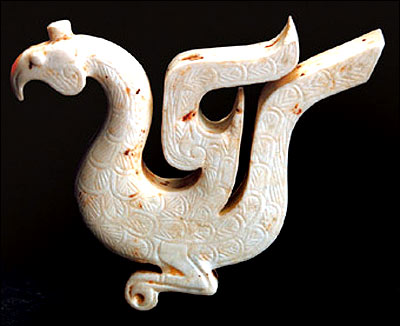
Archaeologists also found remains of river courses and
piers, indicating that both land and waterway modes of transport
were used in the ancient capital.
10. Winery Remains in Mianzhu City,
Sichuan Province.
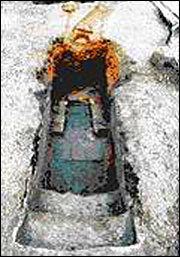
Mianzhu City in southwest China's Sichuan Province
boasts a 4,000-year-old history of wine-making. When demolishing
its old factory buildings in April 2003, the Mianzhu-based
Jiannanchun Group Ltd Co found the ruins of a winery measuring some
12,000 square meters. Immediately, a joint team from the Sichuan
Provincial Cultural Relics and Archaeology Academy, and the Deyang
Municipal Cultural Relics and Archaeology Institute began a survey
and trial excavation of the site that lasted until August. The
excavation resumed from August to November in 2004.
In total, they dug an area of 800 square meters, unearthing
wells, wine cellars, stoves, barns, distillation equipment,
ditches, building foundations and roadbeds dating back to the Qing
Dynasty (1644-1911), according to team leader Chen De'an.
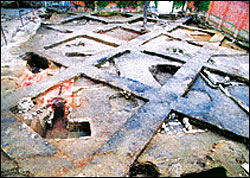
The well-preserved remains indicate that the winery
was composed of a number of small workshops in which different
kinds of liquor were produced. The striking finds at the site
helped to restore the traditional wine-making technology and in
learning more about the development of the handicraft industry that
existed at the time.
Further excavation might reveal more clues that could extend the
history of the remains back to the Ming (1368-1644) and Song
(960-1279) dynasties, said Ning Zhiqi, head of Mianzhu's cultural
relics conservation and management office.
(China.org.cn July 7, 2005)